
March 2016
Mexico: Grupo
Espartaquista
Boycotts the Class Struggle
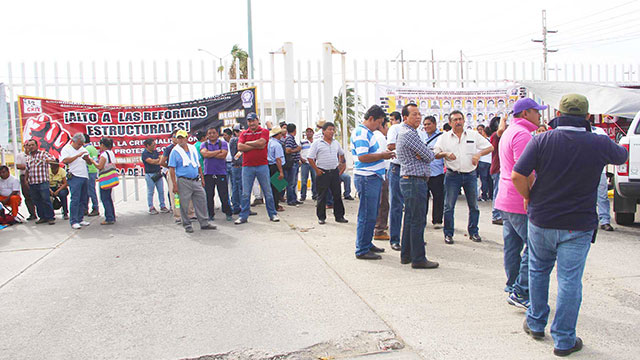
Five hundred teachers of Section 22 blockaded the Pemex refinery in Salina Cruz, Oaxaca for several days in the framework of the boycott of the June 2015 elections. The call to shut down the phony elections was issued by the CNTE and the parents of the Ayotzinapa teachers college students killed and disappeared in September 2014. The Grupo Internacionalista participated in the picket. (Photo: Noticias)
The following article is translated from Revolución Permanente No. 6 (March 2016), the newspaper of the Grupo Internacionalista/México, section of the League for the Fourth International.
In the most recent issue of its magazine, the Grupo Espartaquista de México (GEM) published a front-page article titled, “Trotskyism vs. Radical Populism on Bourgeois Democracy” (Espartaco, November 2015). The main aim of the article is to put forward a correction to its position favoring the boycott of the elections last June, and to polemicize against the Grupo Internacionalista on the same subject.
Actually, the GEM’s support for the boycott was quite timid. In a 30 April 2015 leaflet, it wrote: “The call for the boycott … is both a protest against state brutality and an expression of being fed up with the electioneering parties and the whole electoral circus…. We Spartacists solidarize with the boycott.” But for the priests of the International Communist League (ICL), of which the GEM is the Mexican section, even this modest and abstract gesture, dipping its toe in the waters of the class struggle, was too much. According to its self-criticism, “we should have argued and frankly warned against the use of this tactic under present conditions.”
Up to now, Marxists have held that the revolutionary program should be a guide to action. One of the many innovations introduced by the ICL in its zigzag course in the post-Soviet period has been to convert the program into a recipe for inaction. Thus, in taking up the subject, it goes on at length about bourgeois “democracy” and the various prophylactic prohibitions it has come up with recently to protect itself against the temptation of opportunism. In particular:
–A ban on “participating in elections for executive posts,” even with a revolutionary program, because a revolution “necessarily implies a settling of accounts with the executive.” But will there be no “settling of accounts” with the bourgeois parliaments? What about parliamentary regimes where any deputy could be a minister tomorrow? For Trotskyists, our opposition to administrating the capitalist state does not prevent us from making use, at particular times, of an election campaign as a platform for revolutionary propaganda.
–Opposing, “as a matter of principle, calls for a constituent assembly,” because this “amounts to a bourgeois government.” The clueless Lenin and Trotsky (as well as the ICL in previous decades) had overlooked this universal principle. We’re curious about how this squares with the ICL’s opportunist position of retrospectively coming out in favor of the French Constitution of 1946? We Trotskyists reject the slogan under current conditions in Mexico, but we don’t exclude tactically raising the call for a revolutionary constituent assembly in dictatorial regimes, at the same time as we fight for the formation of soviets to carry out the socialist revolution.
Following this excursion through the looking glass into the pseudo-Marxist wonderland of the post-Soviet ICL, we arrive at the core of the “correction.” The self-criticism is right on one point: the GEM’s original leaflet confused an electoral boycott with abstention, saying: “For us, calling for a no vote in this country is nothing new.” While in Spanish and other languages, a boycott clearly means the attempt to stop the elections, the normal meaning of boycott in English is simply not to participate in them. Could this be the reason for confusing the two tactics?
But beyond linguistic confusion, the nub of the question is another invention by the latter-day Spartacists: its definition, according to which an “active boycott” would only be “the antechamber to and conscious preparation for an insurrection,” a tactic which “only has a chance of success in the context of a qualitatively higher level of class struggle than has existed in Mexico in many decades, and perhaps in its entire history.” To shore up its position that an electoral boycott is impossible short of a revolutionary crisis and imminent insurrection, they put forward a series of fraudulent assertions … and a distorted quotation from Lenin.
In the first place, the GEM’s rectification claims that the boycott covered all of Mexico, when in actuality the only serious attempt to carry out the call put out by the parents of the 43 disappeared students from Ayotzinapa1 and by the combative teachers of the CNTE (National Coordinating Committee of Education Workers) was in the states of Guerrero, Oaxaca and Chiapas. These strongholds of the CNTE have been convulsed by social protest and police repression ever since that fateful night in Iguala, Guerrero in September 2014 [when the students were massacred and kidnapped]. The GEM the argues that boycott actions “were limited to a few municipalities,” and that only “Some 600 ballot stations were not installed or were closed for different reasons in all of Mexico, out of a total of 150,000.” Wrong.
It seems that this erroneous data comes from the National Election Institute (INE), but in the state of Oaxaca alone, the local branch of the INE reported that “283 election stations were destroyed by the dissident teachers in the 11 electoral districts in the state,” that ballot boxes were stolen from another 26 election stations, that an additional 75 election stations cancelled voting “due to the risk of violence,” and yet another 135 election stations were never set up. And not only that: in order to gussy up its figures, the state INE reduced the total number of election stations from 5,228 initially to 4,059 in the end. At the same time, in Guerrero there were reportedly 113 election stations which were not set up, or where voting was suspended.
In order to back up its supposition that “many leftists must be disappointed by these results, and by the scant effect of the movement for electoral boycott, the GEM claims that voting participation was the highest in decades in mid-term elections. Not in Oaxaca, where the level of abstention was 59%, and in the central election districts almost three quarters of registered voters (72%) either did not vote or cast a blank ballot. In fact, those who have criticized the boycott, notably the Stalinists of the Frente Popular Revolucionario (FPR), complained not that it was a failure but the opposite: they argue that it aided the PRI, the governing party, because many of those who would have backed the opposition did not vote.
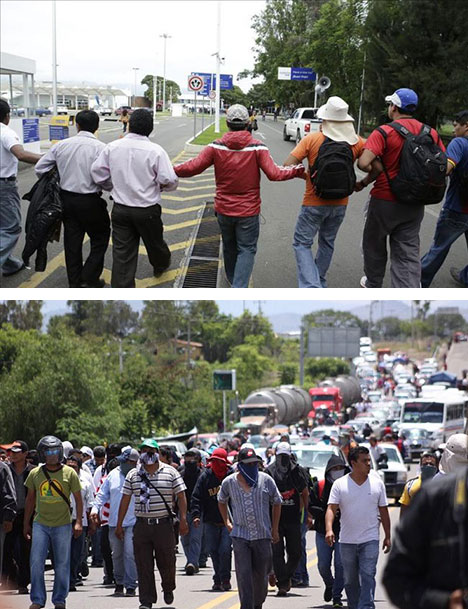 Blockades of the Oaxaca International Airport
(above) and of the nearby Pemex fuel supply depot (below). The
Grupo Internacionalista joined in both actions.
(Fotos: EFE; Crónica)
Blockades of the Oaxaca International Airport
(above) and of the nearby Pemex fuel supply depot (below). The
Grupo Internacionalista joined in both actions.
(Fotos: EFE; Crónica) The GEM article distorts the true context of the call for the electoral boycott and that it had an effect. In the southern states wracked by turmoil, months of incursions of the army had been unable to subjugate the population. In dozens of municipalities in Guerrero mayors were expelled by the population, and many were being governed by communal assemblies. In this situation, the murderous government of Enrique Peña Nieto sought to put an end to the rebellion by means of the elections. In the face of this challenge, the rebels called for a boycott in order to block the effort to put an end to the crisis. The federal government ended up sending in tens of thousands of soldiers and gendarmes (an elite unit of the Federal Police set up in 2014) in order to impose the elections at gunpoint. And what does the GEM do? It desolidarizes itself from the boycott.
Not only that. We read: “This effort meant a direct confrontation with the repressive forces of the capitalist state…. The toll, on the other hand, was of dozens of people arrested and injured in clashes with the police, in addition to one teacher murdered.” Forget about the GEM’s pretense of defending the CNTE against the government: these shameless fake-Trotskyists are blaming the teachers, the students and the parents of the Ayotzinapa 43 for having caused the repression. In fact, its criticism of the boycott is a carbon copy of that of the faker Flavio Sosa, a bourgeois politician who is currently acting as the main supporter in Oaxaca of the National Renovation Movement (Morena) of Andrés Manuel López Obrador.
The Grupo Internacionalista, in contrast, took sides and acted in the struggle against the electoral farce in those area where the boycott had mass support, without holding back about its limitations. We wrote then:
“In this worst crisis of bourgeois ‘governability’ that Mexico has seen in the last half century, the Grupo Internacionalista (GI) stands with, and has participated in, the struggle of the teachers and parents of the disappeared students against the fraudulent elections, at the same time as we warn that an electoral boycott, as justified as it is, cannot put an end to the bloodbath and the assault on teachers. If mass action is limited to the confines of the mostly rural states of the southwest, the bosses’ government can hold out, and wait for a more propitious time to give the death blow. As we have emphasized since the beginning of the protests, as well as during the ‘teacher insurgency’ of 2013, what’s needed is a working-class mobilization throughout the country, a nationwide strike drawing in key sectors of the Mexican proletariat, on the road to a socialist revolution to bring down the capitalist regime that has turned Mexico into a giant cemetery.”
–“Mexico: Down With Elections Under the Military Boot!” The Internationalist No. 40, Summer 2015
In order to condemn the revolutionary class politics of the Grupo Internacionalista, the GEM has resorted to all manner of subterfuges. It proclaims that “the call to prevent the elections could not have won without the mobilization of the working class,” but at the same time ridicules our call for a national strike extending to sectors of the proletariat. The GEM criticizes us for “inventing” a qualitative difference between the CNTE and “the rest of the SNTE, which due to its subordination to the PRI is supposed to be ‘the class enemy’,” while remaining silent about the fact that this corporatist pseudo-union (the SNTE), which is part of the state apparatus, has murdered more than 150 dissident teachers. At the same time, it seems to be ignorant of the fact that the leaders of Section 22, the “pelones” and “pozoleros” (two allied cliques), who have been denounced by the rank-and-file, are in fact PRI supporters.
The GEM claims that “Considerations such as the issue of leadership, the balance of forces, the organization and political consciousness of the working class are of little importance to the braggarts and verbal adventurers of the GI, including when they call for a ‘workers rebellion’ in a single, overwhelmingly rural state.” Readers can easily see for themselves that the Grupo Internacionalista fights inside the CNTE against the class-collaborationist policies of the leadership (and of its Stalinist opponents): “In the face of the evident disorientation of the leaders of the CNTE and Section 22, it is urgently necessary to forge a revolutionary leadership that is up to the tasks posed by this hard class battle, and whose main axis is full political independence from the bourgeois parties and politicians” (“Defeat the Union-Busting Attack on Mexican Teachers,” The Internationalist, August 2015). The GEM, on the other hand, does nothing.
The correction by Espartaco contains so many distortions, omissions and outright lies that it would be difficult to list them all. It claims that the CNTE “has an extremely limited social power,” when Section 22 has been the axis of the union movement in Oaxaca that in 2006 was able to expel the government and the police from the state capital for five months. (In reality, the GEM’s criticism is the Mexican version of the LCI thesis that Bolivia has no proletariat.) But in order to stamp the seal of authority on its rejection of the boycott, its drop-dead argument is a quote from Lenin. Here it is:
“The connection between boycott and the broad revolutionary upswing is thus obvious: boycott is the most decisive means of struggle, which rejects not the form of organization of the given institution but its very existence. Boycott is a declaration of open war against the old regime, a direct attack upon it. Unless there is a broad revolutionary upswing, unless there is mass unrest which overflows, as it were, the bounds of the old legality, there can be no question of the boycott succeeding.”
–V.I. Lenin, “Against Boycott” (July 1907)
Now this stance by the Bolshevik leader deals with the question of under what circumstances revolutionaries should call for a boycott, while the present case concerns, as the “rectification” by the GEM admits, the “electoral boycott by the CNTE and its allies, a conjunctural action based on being fed up with the repression and corruption of the PRI, PAN and PRD” [our emphasis]. Secondly, in speaking of a “broad revolutionary upswing” and “mass unrest which overflows … the bounds of the old legality,” Lenin does not say (as the ICL maintains) that the boycott is only admissible as the “antechamber and conscious preparation of the insurrection.” We of the GI did not take a position until ascertaining that the call had a mass impact, and in fact in the affected areas there was a broad “mass agitation” which “overflowed the old legality.”
However, the most relevant thing about the Lenin quote is that it is referring to 1907. The ICL doesn’t mention that in 1906 the very same Lenin called for a boycott of the tsarist Duma, and that the Bolshevik leader made an emphatic defense of this position against the Mensehviks who raised the same arguments which the GEM and the ICL repeat today. Today these fake Trotskyists say that boycott was dismissed in 1907 because, “The 1905 Revolution had been defeated, and the Russian workers movement was fighting to regroup and overcome demoralization in the midst of police persecution, executions and poverty made more acute by lockouts.” But what did the Bolsheviks say in 1906 when they called for a boycott?
Lenin’s article, “The State Duma and Social-Democratic Tactics” (January 1906) reproduces the resolution of the Bolshevik majority, saying: “The government has drenched the country in blood, shooting down with artillery and machine guns the workers, peasants, soldiers and sailors fighting for liberty.” Lenin comments that, “These considerations – together with the suppression of the insurrection in Moscow and elsewhere, after which some period of lull is necessary to rally and train fresh forces – have naturally been inclining the ‘Minority’ [i.e., the Mensheviks] in the RSDRP (Russian Social Democratic Workers Party) in favor of participation in the election….” Despite the unfavorable balance of the relation of forces, the Majority conference decided that “This conference holds that the Social Democrats must strive to prevent the convocation of this police Duma, and must refuse to take any part in it.”
In a subsequent article, “The Present Situation in Russia and the Tactics of the Workers Party” (February 1906), Lenin writes: “The Russian Social-Democratic Party is passing through a very difficult time. Martial law, shootings and floggings, overcrowded prisons, a proletariat worn out by starvation, chaos in organization, aggravated by destruction of many of the underground centres and by the absence of legal centers, and lastly the controversy over tactics … are all inevitably causing a certain disarray of Party forces.” Nevertheless, Lenin concludes that “all idea of participating in the Duma must be emphatically discarded. We must more perseveringly and patiently prepare for a new insurrection and establish closer links with the organizations of the peasantry….”
Not so the Mensheviks: Georgi Plekhanov lambasted the “inopportunely begun” mass strike which led to the armed uprising in Moscow at the end of 1905, concluding: “The strength of the proletariat proved inadequate for victory. It was not difficult to foresee this. And therefore it was wrong to take up arms.” The task of the hour, explained the theoretician, “is to point out to the proletariat its mistake….” Lenin added: “Quite naturally, Plekhanov also declares against boycotting the Duma….” So just as in 1905 the Menshevik Plekhanov criticized the Moscow workers, saying that “it was wrong to take up arms,” today his offspring, the neo-Plekhanovists of the ICL, say that the Oaxaca and Guerrero workers should not have boycotted the elections.
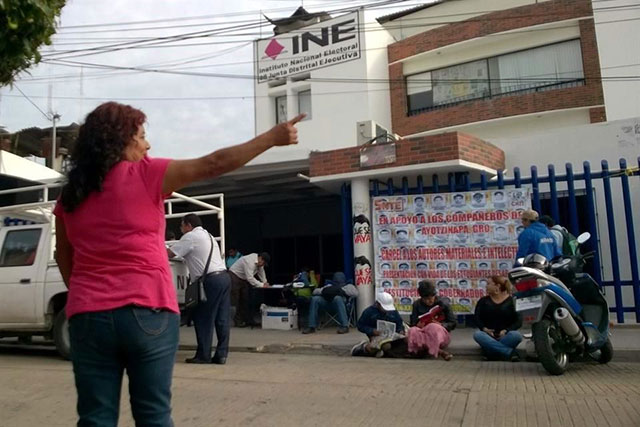
Teachers of Section 22 blocked district offices of the National Election Institute in the framework of their boycott of the phony elections, blaming the government for the disappearance of the 43 Ayotzinapa students. (Foto: Reforma)
The ultimatistic position of the ICL, that one cannot call for – or even solidarize with – an electoral boycott except on the eve of an armed insurrection, has nothing Bolshevik about it. On the contrary, this is 21st century Menshevism. Nor is it an isolated position. In previous years, these ex-Trotskyists have declared that one cannot call for a general strike without already having a mass revolutionary workers leadership and being prepared for a direct struggle for power. At the same time, in Mexico and more recently in Greece, the ICL has opposed our calls to fight for workers control and rejected any struggle that isn’t simply defensive. Hiding behind its distorted vision of the balance of forces, these centrist opportunists mouth supposedly leftist arguments in order to arrive at the same conclusion as the reformists: accepting the limits of capitalism.
There was nothing passive about the struggle undertaken by the teachers of the CNTE and other trade-unionists to prevent the electoral fraud. We have described how supporters of the boycott shut down the airport with a blockade by hundreds of teachers; how they also blockaded the Pemex fuel depot in El Tule; and how educators in the Isthmus of Tehuantepec blockaded the refinery of Salina Cruz. Trade-unionists from the public health sector and members of the GI participated in all of these actions. In addition, teachers of the combative Section 22 of the CNTE sacked more than a dozen district offices of the INE in Juchitán and elsewhere; and they occupied the Temescal hydroelectric plant in the Cuenca region, one of the most important electrical facilities in the country.
In fact, it is for leading these powerful actions that the government has arrested four of the intermediate-level cadres of Section 22. The Trotskyists of the Grupo Internacionalista have actively participated in forums in the Zócalo (main plaza) of Oaxaca and in caravans to the maximum-security prisons demanding the freeing of the dozens of imprisoned teachers and activists. In contrast, the GEM has done nothing to defend them, apart from a single mention in its magazine, even as it criticizes them for having brought down repression with their exemplary action. With its treacherous and supposedly learned rhetoric, it has become a specialist in “pulling your hands out of the boiling water” of the class struggle. With its shameful critique of the courageous teachers and students for having called the electoral boycott going up against the capitalist state, the ICL and the GEM are boycotting the class struggle. ■
- 1. See “Huge Outrage Over Guerrero Massacre,” The Internationalist No. 38, October-November 2014.
The
Battle of the Electoral Boycott in Guerrero
In Guerrero, the electoral boycott assumed the proportions of a pitched battle between the various police forces and the population, above all in the cities of Tixtla and Tlapa. In Tixtla, the residents prevented electoral activity for several months. Their placards declared, “There Will Be No Elections – We’re Missing 43,” referring to the disappeared students from the nearby Ayotzinapa Rural Teachers College. On June 6, the day before the phony elections, there was a march of some 4,000 people led by the parents of the 43. On voting day there were highway blockades, burning of election material and a massive confrontation between the population and the police, as one can see in the photos below. They were able to shut down half the election districts in the city and to repel an attack by shock troops of the PRI on the city hall, which has been occupied for several months by the CETEG (Guerrero State Coordinating Committee of Education Workers), the section of the national CNTE.
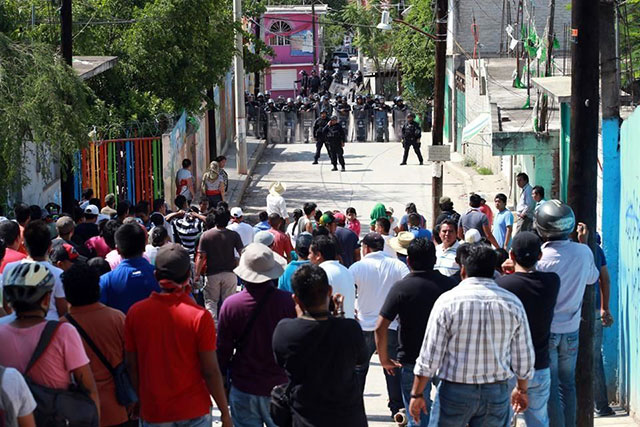
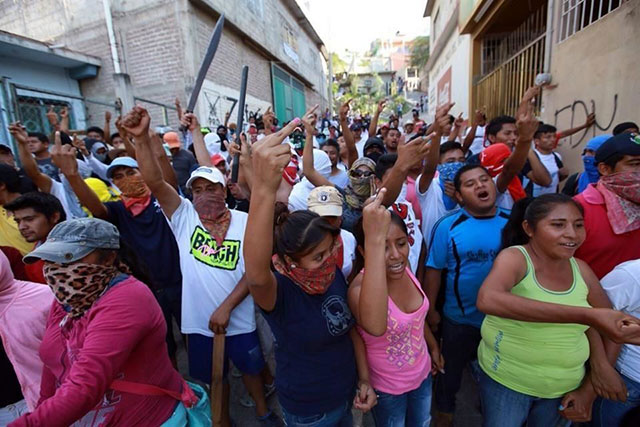
Hundreds of residents of Tixtla, Guerrero confront heavily armed riot police on election day, 7 June 2015. Half the election stations were blocked. (Photos: Reforma)
In Tlapa, the main city of the La Montaña region and a stronghold of the CETEG, the police were even more aggressive. On June 5, a joint commando of municipal and state police evicted the Guerrero Popular Movement which has been occupying city hall. The uniformed thugs also attacked a demonstration of teachers and local residents, showering them with rocks and leaving at least ten injured and several arrested. One demonstrator was stabbed by members of the PRI shock troop, Los Cholos. In the face of the police assault, demonstrators held a policeman in order to exchange him for their arrested comrades.
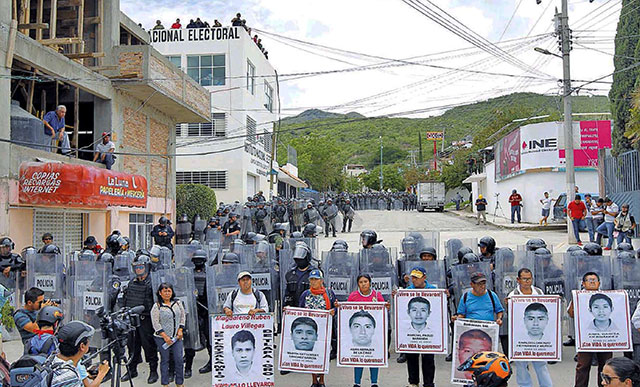
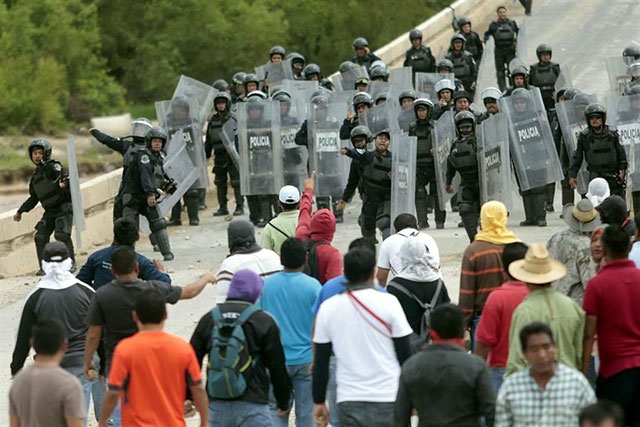
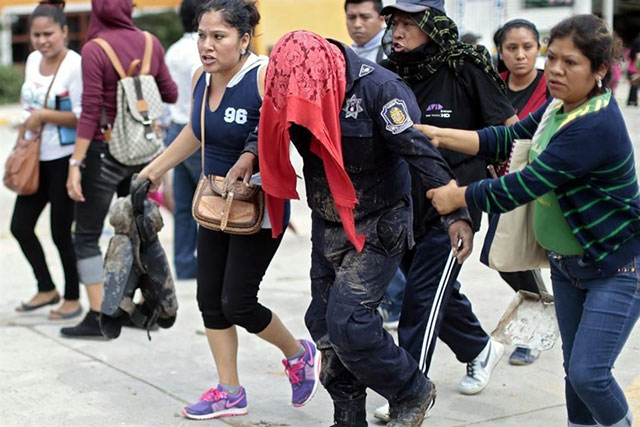
Scenes from the battle in the Tepeyac barrio of Tlapa, Guerrero, on 5 June 2015. Two days later Federal Police attacked, killing an activist, badly beating a teachers union leader and arresting ten teachers.
(Photos: Víctor Camacho/La Jornada; Reforma)
On election day, June 7, a commando of the Federal Police (PF) penetrated the El Tepeyac barrio looking for a “cell” of the MPG, which they blamed for the burning of a police van. They proceeded to the CETEG headquarters, located in the same neighborhood, arresting several teachers. They also burst into the homes of teachers who were prominent for their trade-union militancy, hauling them off to the state capital. In response to this blatant police aggression, church bells summoned the neighbors. Hundreds of residents poured out of their homes. They surrounded the detachment of police and disarmed them, taking them to the chapel where they were held in order to exchange them for arrested protesters.
But the PF higher-ups refused any negotiation. In the evening they cut off electricity to the barrio and under the cover of darkness, the federales launched a lightening attack to seize the arrested cops, which by then had risen to 35 in number. They administered a brutal beating to the teacher Juan Tenorio, leader of the CETEG, and a federal police sniper killed the MPG head of security, Antonio Vivar Díaz, shooting from the Church of Our Lady of Guadalupe. The outraged neighbors responded with a hail of rocks. Once the police managed to flee, a PF officer ordered, “Escape. We’re out of here, or else these bastards will surround us again. Flee, flee” (“The Battle of Tepeyac,” Reforma, 8 June 2015).
The population, with the combative teachers at the head, courageously resisted. But according to the pseudo-Trotskyist GEM, they shouldn’t have boycotted these elections which were imposed with blood and fire by the murderous government in order to put an end to the upheaval. To top it off, these imposters blame the teachers and the parents of the disappeared students who called the boycott for bringing down the repression. Take a good look at those faces: these are the people the ICL betrayed. ■
